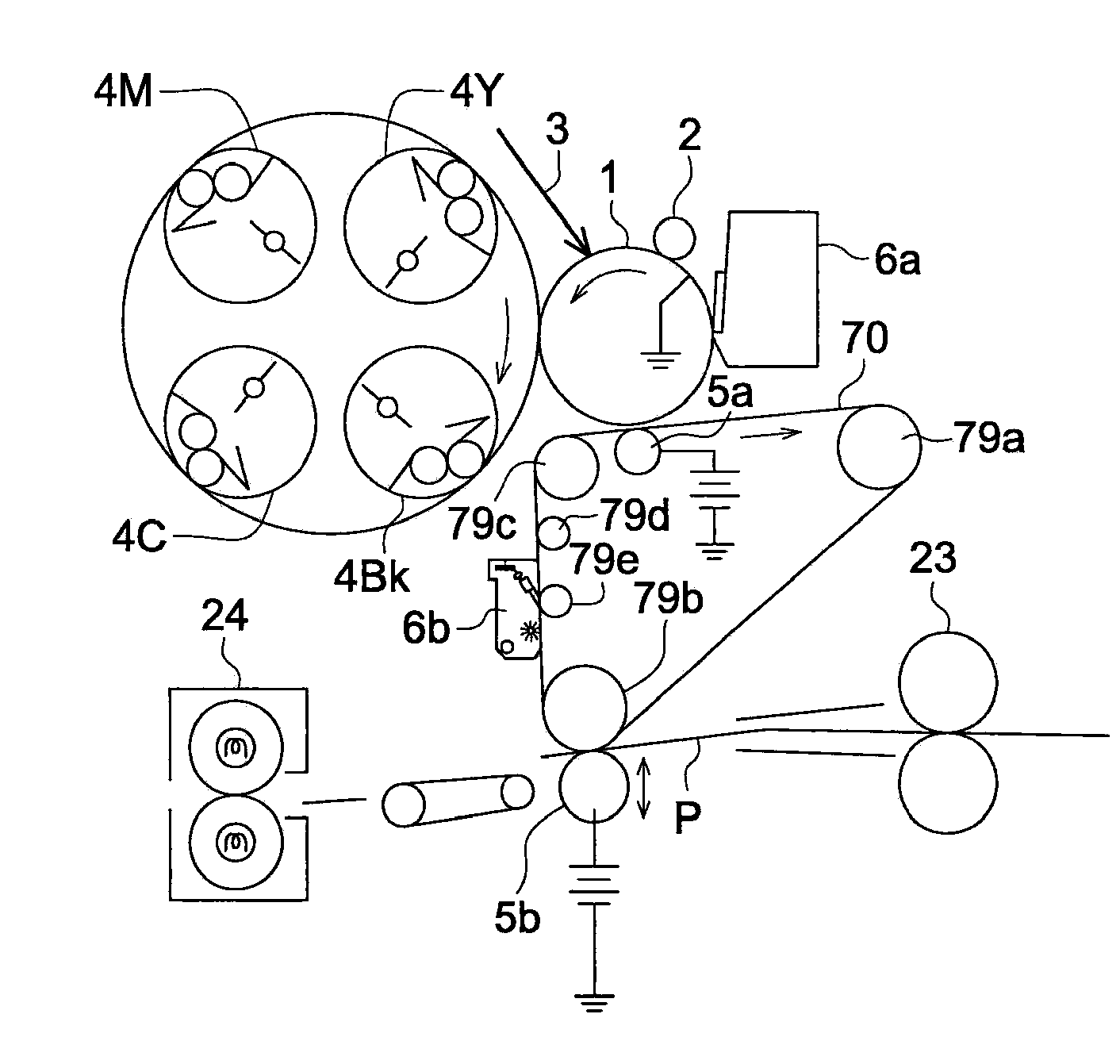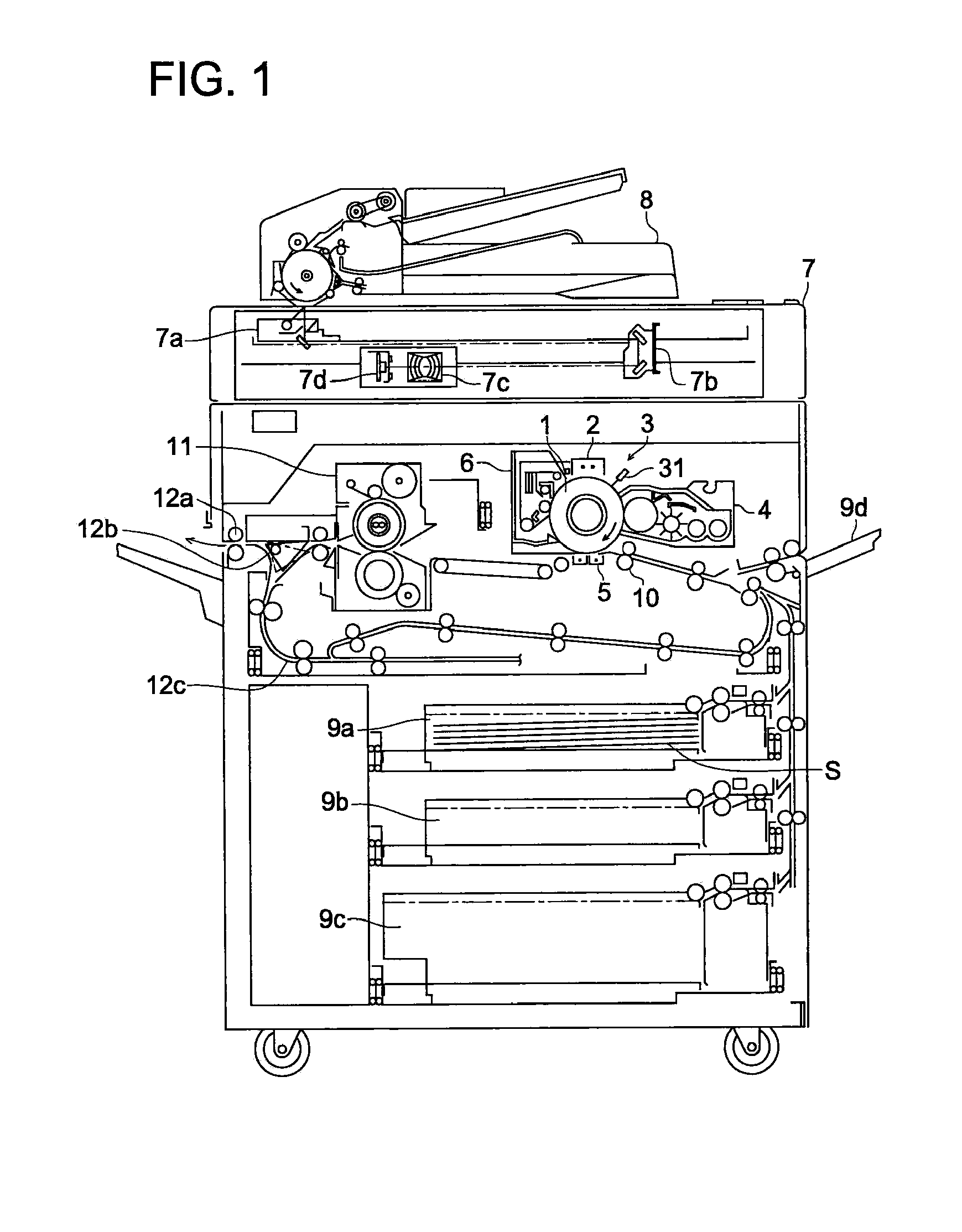Electrophotographic photoreceptor and image formation apparatus
a photoreceptor and photoreceptor technology, applied in the field of electrophotographic photoreceptor and image formation apparatus, can solve the problems of insufficient high image quality of electrophotographic image finally obtained, insufficient photosensitive properties of electrophotographic photoreceptor, and insufficient gradation of halftone image, etc., to achieve good gradation characteristics of halftone image, reduce image noise such as black spots or fogging, and reduce the effect of generation
- Summary
- Abstract
- Description
- Claims
- Application Information
AI Technical Summary
Benefits of technology
Problems solved by technology
Method used
Image
Examples
synthesis example 1
[0039]CGM-1 (Mixture of n=1 to 3)
[0040]First, 5.0 g by mass of 8,16-pyranthrenedione and 0.25 g of iodine were dissolved in 50 g of chlorosulfuric acid and further thereto, 3.0 g of bromine are dropwise added. After completing addition, the reaction mixture was heated to 50° C. and stirred for 3 hours with heating to undergo reaction. After completion of the reaction, the reaction mixture was cooled to room temperature and poured into 500 g of ice. After filtering and washing, drying was performed to obtain 6.8 g of pigment raw material.
[0041]Into a glass tube made of PYREX (trade name) was placed 5.0 g of the obtained pigment raw material. The glass tube was disposed in a furnace structured to provide a temperature gradient of ca. 440° C. to ca. 20° C. along the tube (capable of having a temperature gradient of ca. 440° C. to ca. 20° C. per 1 m). While the interior of the glass tube being evacuated to 1×10−2 Pa, the position at which the glass tube containing a pyranthrone compound...
synthesis example 2
[0043]CGM-2 (Mixture of n=3 to 5)
[0044]Dissolved were 5.0 g of 8,16-pyranthrenedione and 0.25 g of iodine in 50 g of chlorosulfuric acid and further thereto, 5.9 g of bromine were dropwise added. After completing addition, the reaction mixture was heated to 70° C. and stirred for 5 hours with heating to undergo reaction. After completion of the reaction, the reaction mixture was cooled to room temperature and poured into 500 g of ice. After filtering and washing, drying was performed to obtain 8.5 g of pigment raw material.
[0045]Into a glass tube made of PYREX (trade name) was placed 5.0 g of the obtained pigment raw material. The glass tube was disposed in a furnace structured to provide a temperature gradient of ca. 460° C. to ca. 20° C. along the tube (capable of having a temperature gradient of ca. 460° C. to ca. 20° C. per 1 m). While the interior of the glass tube being evacuated to 1×10−2 Pa, the position at which the glass tube containing a pyranthrone compound to be purifie...
synthesis example 3
[0047]CGM-3 (Mixture of n=3 to 6)
[0048]Dissolved were 5.0 g of 8,16-pyranthrenedione and 0.25 g of iodine in 50 g of chlorosulfuric acid and further thereto, 5.9 g of bromine were dropwise added. After completing addition, the reaction mixture was heated to 75° C. and stirred for 6 hours with heating to undergo reaction. After completion of the reaction, the reaction mixture was cooled to room temperature and poured into 500 g of ice. After filtering and washing, drying was performed to obtain 8.7 g of pigment raw material.
[0049]Into a glass tube made of PYREX (trade name) was placed 5.0 g of the obtained pigment raw material. The glass tube was disposed in a furnace structured to provide a temperature gradient of ca. 480° C. to ca. 20° C. along the tube (capable of having a temperature gradient of ca. 480° C. to ca. 20° C. per 1 m). While the interior of the glass tube being evacuated to 1×10−2 Pa, the position at which the glass tube containing a pyranthrone compound to be purifie...
PUM
| Property | Measurement | Unit |
|---|---|---|
| surface roughness Rz | aaaaa | aaaaa |
| length | aaaaa | aaaaa |
| aspect ratio variation coefficient | aaaaa | aaaaa |
Abstract
Description
Claims
Application Information
 Login to View More
Login to View More - R&D
- Intellectual Property
- Life Sciences
- Materials
- Tech Scout
- Unparalleled Data Quality
- Higher Quality Content
- 60% Fewer Hallucinations
Browse by: Latest US Patents, China's latest patents, Technical Efficacy Thesaurus, Application Domain, Technology Topic, Popular Technical Reports.
© 2025 PatSnap. All rights reserved.Legal|Privacy policy|Modern Slavery Act Transparency Statement|Sitemap|About US| Contact US: help@patsnap.com



